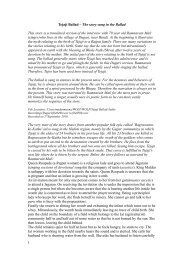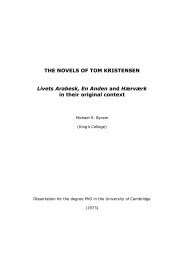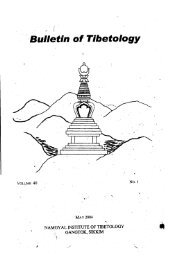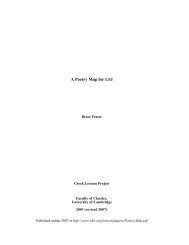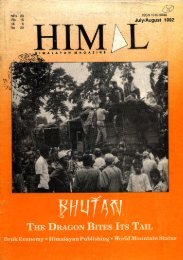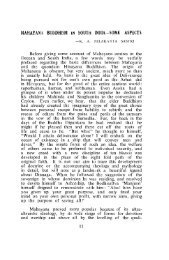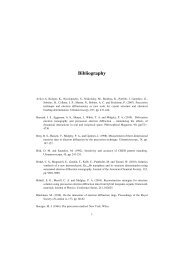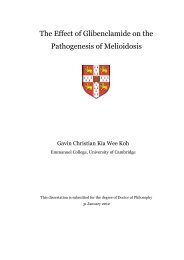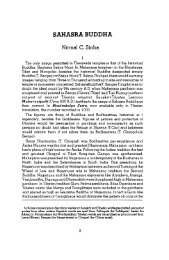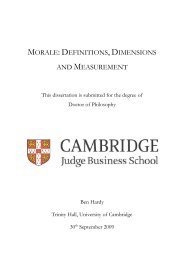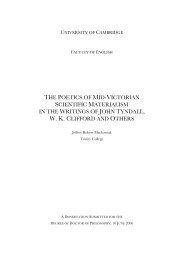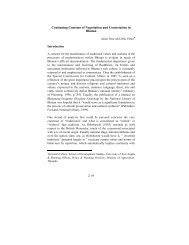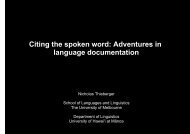The Crusades, the Genoese and the Latin East - DSpace at ...
The Crusades, the Genoese and the Latin East - DSpace at ...
The Crusades, the Genoese and the Latin East - DSpace at ...
You also want an ePaper? Increase the reach of your titles
YUMPU automatically turns print PDFs into web optimized ePapers that Google loves.
<strong>The</strong> first wave of <strong>Genoese</strong> crusaders was led by seven of <strong>the</strong> most influential figures in<br />
Genoa: Guido Spinola, Nicola Embriaco, Fulco de Castello, Simone Doria, Baldovino Guercio,<br />
Spezzapietra <strong>and</strong> Rosso della Volta. All of <strong>the</strong>m had served as consuls of <strong>the</strong> commune in <strong>the</strong><br />
past, <strong>and</strong> Guido Spinola embarked as an acting consul <strong>and</strong> leader of <strong>the</strong> mission. <strong>The</strong> dedic<strong>at</strong>ion<br />
to <strong>the</strong> cause of <strong>the</strong> crusade was very high in Genoa. It can be seen not only in <strong>the</strong> fact th<strong>at</strong> <strong>the</strong>se<br />
important personnel went on <strong>the</strong> crusade, but also in <strong>the</strong> light of <strong>the</strong> <strong>Genoese</strong> contribution in<br />
b<strong>at</strong>tle. <strong>The</strong> annals mention many o<strong>the</strong>r knights <strong>and</strong> war machines th<strong>at</strong> <strong>the</strong> <strong>Genoese</strong> shipped to <strong>the</strong><br />
<strong>L<strong>at</strong>in</strong> <strong>East</strong>: `et multi alii nobiles milites et pedites civit<strong>at</strong>is Ianuae, qui in castris ei obsidione<br />
predicte ciuit<strong>at</strong>is [i. e. Acre] uiriliter sleterunt, et castella lignea et machina et alia bellica<br />
instrumenta ibi erexerunt. '30 Even more impressive are Conrad of Montferr<strong>at</strong>'s descriptions of <strong>the</strong><br />
<strong>Genoese</strong> contribution. <strong>The</strong>se descriptions are found in <strong>the</strong> charter Conrad granted <strong>the</strong> commune<br />
on 11 April 1190:<br />
Recolentes igitur quam magnifice et laudabiliter civitas Ianue pro liber<strong>at</strong>ione orientalfs<br />
regionis... cognoscentes probit<strong>at</strong>em eorumdem civium in principio huius captivit<strong>at</strong>is<br />
quam viriliter illud modicum christianorum quod superer<strong>at</strong> de faucibus paganorum<br />
eripere et defendere studuerit, quam etiam magnifice in presenti obsidione civit<strong>at</strong>is<br />
Acconensis consul prenomin<strong>at</strong>us [i. e Guido Spinola] una cum nobilibus civibus et<br />
reliquo populo suo tanquam veri Machabei castella, machinis, militibus, pedilibus,<br />
balistariis et sagittariis se habuerint, marl terraque laboraverint... [my emphasis]"<br />
<strong>The</strong>se descriptions of <strong>the</strong> <strong>Genoese</strong> contribution to <strong>the</strong> war efforts in <strong>the</strong> <strong>L<strong>at</strong>in</strong> <strong>East</strong> are<br />
repe<strong>at</strong>ed, with similar superl<strong>at</strong>ives, in all of <strong>the</strong> concessions granted to <strong>the</strong> <strong>Genoese</strong> in this period.<br />
It is interesting to note, however, th<strong>at</strong> <strong>the</strong> paragraphs th<strong>at</strong> proclaim <strong>the</strong> merits of <strong>the</strong> <strong>Genoese</strong> refer<br />
in particular to <strong>the</strong> contribution of <strong>the</strong> <strong>Genoese</strong> <strong>at</strong> <strong>the</strong> siege of Acre 32 This is interesting because<br />
contemporary charters do not usually rel<strong>at</strong>e long stories. For example, in Conrad's confirm<strong>at</strong>ion<br />
of <strong>the</strong> Venetians privileges in 1191 his language was very technical'33 <strong>and</strong> in <strong>the</strong> reconfirm<strong>at</strong>ion<br />
of <strong>the</strong> Pisan rights he briefly mentioned th<strong>at</strong> <strong>the</strong>y worked hard <strong>and</strong> had casualties: `... labores et<br />
varios sudores ac sanguinis effusionem civium Pisanorum. ' Privileges th<strong>at</strong> were granted to <strong>the</strong><br />
Pisans in <strong>the</strong>se years do not elabor<strong>at</strong>e on <strong>the</strong> details of <strong>the</strong>ir contribution 34<br />
Was <strong>the</strong> <strong>Genoese</strong> help really conspicuous? Interesting evidence for <strong>the</strong> significance of <strong>the</strong><br />
<strong>Genoese</strong> help may be deduced from <strong>the</strong> short list of seven <strong>Genoese</strong> personnel who were<br />
mentioned by name as participants in <strong>the</strong> crusade. As mentioned above, all seven were previously<br />
30 Ann. Jan., vol. 2, p. 33.<br />
31 I Libri lurium, vol. 1/2, no. 331, p. 138.<br />
32 See I Libri lurium, vol. 2, nos. 332,333 (charters by Guy of Lusignan), 334 (Conrad of Montferr<strong>at</strong>), 335<br />
<strong>and</strong> 336 (Henry of Champagne),<br />
<strong>the</strong> l<strong>at</strong>ter repe<strong>at</strong>s <strong>the</strong> comparison between <strong>the</strong> <strong>Genoese</strong> <strong>and</strong> <strong>the</strong> Maccabees<br />
whilst describing <strong>the</strong> siege of Acre. <strong>The</strong>se charters are from 1190 to 1195. See detail analysis of <strong>the</strong>se<br />
charters in Chapter Five.<br />
33 TTh, no. 76, pp. 212-215.<br />
34 Müller, no. 23, p. 26.<br />
24



